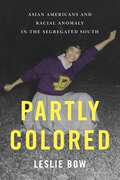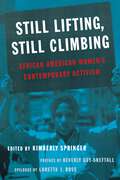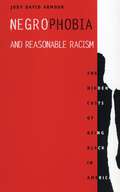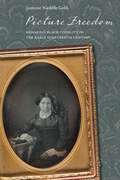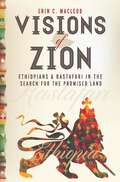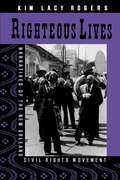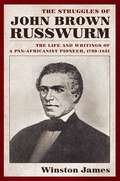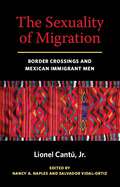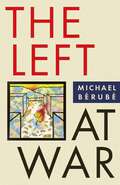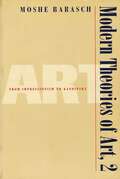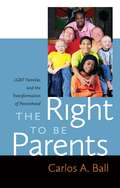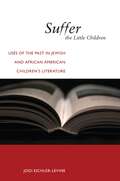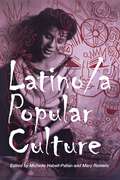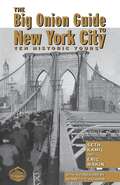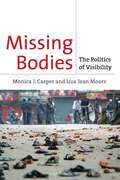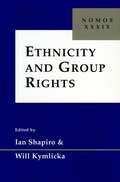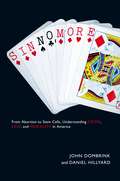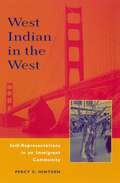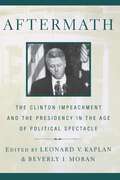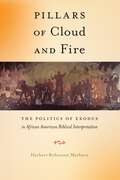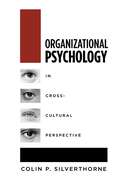- Table View
- List View
Partly Colored: Asian Americans and Racial Anomaly in the Segregated South
by Leslie Bow2012 Honorable mention for the Book Award in Cultural Studies from the Association for Asian American StudiesArkansas, 1943. The Deep South during the heart of Jim Crow-era segregation. A Japanese-American person boards a bus, and immediately is faced with a dilemma. Not white. Not black. Where to sit?By elucidating the experience of interstitial ethnic groups such as Mexican, Asian, and Native Americans—groups that are held to be neither black nor white—Leslie Bow explores how the color line accommodated—or refused to accommodate—“other” ethnicities within a binary racial system. Analyzing pre- and post-1954 American literature, film, autobiography, government documents, ethnography, photographs, and popular culture, Bow investigates the ways in which racially “in-between” people and communities were brought to heel within the South’s prevailing cultural logic, while locating the interstitial as a site of cultural anxiety and negotiation.Spanning the pre- to the post- segregation eras, Partly Colored traces the compelling history of “third race” individuals in the U.S. South, and in the process forces us to contend with the multiracial panorama that constitutes American culture and history.
Still Lifting, Still Climbing: African American Women's Contemporary Activism
by Beverly Guy-Sheftall Kimberly Springer Loretta J. RossStill Lifting, Still Climbing is the first volume of its kind to document African American women's activism in the wake of the civil rights movement. Covering grassroots and national movements alike, contributors explore black women's mobilization around such areas as the black nationalist movements, the Million Man March, black feminism, anti-rape movements, mass incarceration, the U.S. Congress, welfare rights, health care, and labor organizing. Detailing the impact of post-1960s African American women's activism, they provide a much-needed update to the historical narrative. Ideal for course use, the volume includes original essays as well as primary source documents such as first-hand accounts of activism and statements of purpose. Each contributor carefully situates their topic within its historical framework, providing an accessible context for those unfamiliar with black women's history, and demonstrating that African American women's political agency does not emerge from a vacuum, but is part of a complex system of institutions, economics, and personal beliefs. This ambitious volume will be an invaluable resource on the state of contemporary African American women's activism.
Negrophobia and Reasonable Racism: The Hidden Costs of Being Black in America (Critical America #32)
by Jody David ArmourTackling the ugly secret of unconscious racism in American society, this book provides specific solutions to counter this entrenched phenomenon.
Picture Freedom: Remaking Black Visuality in the Early Nineteenth Century (America and the Long 19th Century #20)
by Jasmine Nichole CobbIn the decades leading up to the end of U.S. slavery, many free Blacks sat for daguerreotypes decorated in fine garments to document their self-possession. People pictured in these early photographs used portraiture to seize control over representation of the free Black body and reimagine Black visuality divorced from the cultural logics of slavery. In Picture Freedom, Jasmine Nichole Cobb analyzes the ways in which the circulation of various images prepared free Blacks and free Whites for the emancipation of formerly unfree people of African descent. She traces the emergence of Black freedom as both an idea and as an image during the early nineteenth century. Through an analysis of popular culture of the period—including amateur portraiture, racial caricatures, joke books, antislavery newspapers, abolitionist materials, runaway advertisements, ladies’ magazines, and scrapbooks, as well as scenic wallpaper—Cobb explores the earliest illustrations of free Blacks and reveals the complicated route through visual culture toward a vision of African American citizenship. Picture Freedom reveals how these depictions contributed to public understandings of nationhood, among both domestic eyes and the larger Atlantic world.
Visions of Zion: Ethiopians and Rastafari in the Search for the Promised Land
by Erin C. MacLeodInreggae song after reggae song Bob Marley and other reggae singers speak of thePromised Land of Ethiopia. “Repatriation is a must!” they cry. The Rastafarihave been travelling to Ethiopia since the movement originated in Jamaica in1930s. They consider it the Promised Land, and repatriation is acornerstone of their faith. Though Ethiopians see Rastafari as immigrants, theRastafari see themselves as returning members of the Ethiopian diaspora.In Visions of Zion, Erin C. MacLeod offers the first in-depthinvestigation into how Ethiopians perceive Rastafari andRastafarians within Ethiopia and the role this unique immigrantcommunity plays within Ethiopian society.Rastafariare unusual among migrants, basing their movements on spiritual rather thaneconomic choices. This volume offers those who study the movement a broaderunderstanding of the implications of repatriation. Taking the Ethiopianperspective into account, it argues that migrant and diaspora identitiesare the products of negotiation, and it illuminates the implications of thisnegotiation for concepts of citizenship, as well as for our understandings ofpan-Africanism and south-south migration. Providing a rare look at migration to a non-Western country, this volumealso fills a gap in the broader immigration studies literature.
Righteous Lives: Narratives of the New Orleans Civil Rights Movement
by Kim Lacy RogersAn emotionally evocative, richly textured history based on autobiographical accounts of those who lived and shaped the struggle. The importance of many of Rogers' subjects and the uniqueness of New Orleans make this must reading for anyone interested in the history of the movement. But those interested in oral history and African-American autobiography will find riches aplenty as well. A welcome addition to a number of literatures--Doug McAdam, author of Freedom Summer Righteous Lives skillfully blends oral history with a perceptive analysis of three generations of civil rights leadership in New Orleans. Rogers has revealed not only what people did, but what they remember, and how their assessments of their activism have changed over time.--Donald A. Ritchie, U.S. Senate Historical Office "Rogers paints a slightly less rosy picture, one in which the Louisiana un-American Activities Committee staged a raid on the offices of the Southern Conference Educational Fund (SCEF), and the City Council passed laws prohibiting the right to peaceful assembly, paving the way to jailing protesters."-Gambit Weekly This important study provides fresh insights into the lives of both black and white civil rights leaders, documents the diversity of individuals and motivations, and traces movement history in a major southern city. Well written and well researched, this book is highly recommended for readers at all levels.--Choice Charts the distinctly different experiences and memories of 25 black and white civil rights activists of three 'generations' in New Orleans, opening with a deft sketch of the city's unusual racial background with its black Creole caste.--Publishers Weekly An important study, full of valuable information, profoundly moving testimony, and provocative insights.--The Journal of Southern History A major contribution to our understanding of the civil rights movement. RIGHTEOUS LIVES illustrates the complexity of movements for social change, the long history of seemingly spontaneous conflicts, and the personal consequences of political activism. Rogers reveals how issues of caste and class, of gender and generation divided the black community in New Orleans, while her in-depth interviews and observations bring to the surface previously unexamined contradictions within the white southern experience as well. RIGHTEOUS LIVES also offers perceptive and thought-provoking insights into broader issues of collective and individual memory, life history, and autobiography. It evokes the struggle for African-American self-determination in the Crescent City with clarity and conviction, and it stands as a fitting testimonial to the courageous men and women whose voices provide so much of the book's fascinating narratives and textures.-- George Lipsitz, University of California, San Diego When former Ku Klux Klan Grand Wizard David Duke campaigned for governor in late 1991, race relations in Louisiana were thrust dramatically into the national spotlight. New Orleans, the political and economic hub of the state, is in many ways representative of Louisiana's unique racial mix, a fusion of African-American, Caribbean, European, and white Southern cultures. An old, colorful port famous for its French and Spanish heritage, distinctive architecture, and jazz, New Orleans was a peculiarly segregated city in the 1950s and 1960s. Yet, despite its complicated racial and ethnic identity and heated desegregation battles, New Orleans, unlike other Southern cities such as Birmingham, did not explode. In this moving work, Kim Rogers tells the stories, in their own words, of the New Orleans' civil rights workers who fought to deter the racial terrorism that scarred much of the South in the 1950s and 1960s. Spanning three generations of activists, RIGHTEOUS LIVES traces the risks, triumphs, and disappointments that characterized the lives of New Orleans activists. Chronicling watershed moments in the movement, Rogers' compelling narr
The Struggles of John Brown Russwurm: The Life and Writings of a Pan-Africanist Pioneer, 1799-1851
by Winston James“If I know my own heart, I can truly say, that I have not a selfish wish in placing myself under the patronage of the [American Colonization] Society; usefulness in my day and generation, is what I principally court.”“Sensible then, as all are of the disadvantages under which we at present labour, can any consider it a mark of folly, for us to cast our eyes upon some other portion of the globe where all these inconveniences are removed where the Man of Colour freed from the fetters and prejudice, and degradation, under which he labours in this land, may walk forth in all the majesty of his creation—a new born creature—a Free Man!”—John Brown Russwurm, 1829.John Brown Russwurm (1799-1851) is almost completely missing from the annals of the Pan-African movement, despite the pioneering role he played as an educator, abolitionist, editor, government official, emigrationist and colonizationist. Russwurm’s life is one of “firsts”: first African American graduate of Maine’s Bowdoin College; co-founder of Freedom’s Journal, America’s first newspaper to be owned, operated, and edited by African Americans; and, following his emigration to Africa, first black governor of the Maryland section of Liberia. Despite his accomplishments, Russwurm struggled internally with the perennial Pan-Africanist dilemma of whether to go to Africa or stay and fight in the United States, and his ordeal was the first of its kind to be experienced and resolved before the public eye.With this slim, accessible biography of Russwurm, Winston James makes a major contribution to the history of black uplift and protest in the Early American Republic and the larger Pan-African world. James supplements the biography with a carefully edited and annotated selection of Russwurm’s writings, which vividly demonstrate the trajectory of his political thinking and contribution to Pan-Africanist thought and highlight the challenges confronting the peoples of the African Diaspora. Though enormously rich and powerfully analytical, Russwurm’s writings have never been previously anthologized.The Struggles of John Brown Russwurm is a unique and unparalleled reflection on the Early American Republic, the African Diaspora and the wider history of the times. An unblinking observer of and commentator on the condition of African Americans as well as a courageous fighter against white supremacy and for black emancipation, Russwurm’s life and writings provide a distinct and articulate voice on race that is as relevant to the present as it was to his own lifetime.
No Seat at the Table: How Corporate Governance and Law Keep Women Out of the Boardroom (Critical America #26)
by Douglas M. BransonWomen are completing MBA and Law degrees in record high numbers, but their struggle to attain director positions in corporate America continues. Although explanations for this disconnect abound, neither career counselors nor scholars have paid enough attention to the role that corporate governance plays in maintaining the gender gap in America's executive quarters.Mining corporate governance models applied at Fortune 500 companies, hundreds of Title VII discrimination cases, and proxy statements, Douglas M. Branson suggests that women have been ill-advised by experts, who tend to teach females how to act like their male, executive counterparts. Instead, women who aspire to the boardroom should focus on the decision-making processes nominating committees—usually dominated by white men—employ when voting on membership.Filled with real-life cases, No Seat at the Table opens the closed doors of the boardroom and reveals the dynamics of the corporate governance process and the double standards that often characterize it. Based on empirical evidence, Branson concludes that women have to follow different paths than men in order to gain CEO status, and as such, encourages women to make flexible, conscious, and often frequent shifts in their professional behaviors and work ethics as they climb the corporate ladder.
The Sexuality of Migration: Border Crossings and Mexican Immigrant Men (Intersections #5)
by Lionel CantuWinner of the 2010 Distinguished Book Award from the American Sociological Association, Sociology of Sexualities Section Winner of the 2010 Distinguished Book Award in Latino Studies Honorable Mention from the Latin American Studies AssociationThe Sexuality of Migration provides an innovative study of the experiences of Mexican men who have same sex with men and who have migrated to the United States.Until recently, immigration scholars have left out the experiences of gays and lesbians. In fact, the topic of sexuality has only recently been addressed in the literature on immigration. The Sexuality of Migration makes significant connections among sexuality, state institutions, and global economic relations. Cantú; situates his analysis within the history of Mexican immigration and offers a broad understanding of diverse migratory experiences ranging from recent gay asylum seekers to an assessment of gay tourism in Mexico. Cantú uses a variety of methods including archival research, interviews, and ethnographic research to explore the range of experiences of Mexican men who have sex with men and the political economy of sexuality and immigration. His primary research site is the greater Los Angeles area, where he interviewed many immigrant men and participated in organizations and community activities alongside his informants.Sure to fill gaps in the field, The Sexuality of Migration simultaneously complicates a fixed notion of sexual identity and explores the complex factors that influence immigration and migration experiences.
The Left at War (Cultural Front)
by Michael BérubéThe terrorist attacks of 9/11 and Bush’s belligerent response fractured the American left—partly by putting pressure on little-noticed fissures that had appeared a decade earlier.In a masterful survey of the post-9/11 landscape, renowned scholar Michael Bérubé revisits and reinterprets the major intellectual debates and key players of the last two decades, covering the terrain of left debates in the United States over foreign policy from the Balkans to 9/11 to Iraq, and over domestic policy from the culture wars of the 1990s to the question of what (if anything) is the matter with Kansas.The Left at War brings the history of cultural studies to bear on the present crisis—a history now trivialized to the point at which few left intellectuals have any sense that merely "cultural" studies could have something substantial to offer to the world of international relations, debates over sovereignty and humanitarian intervention, matters of war and peace. The surprising results of Bérubé’s arguments reveal an American left that is overly fond of a form of "countercultural" politics in which popular success is understood as a sign of political failure and political marginality is understood as a sign of moral virtue. The Left at War insists that, in contrast to American countercultural traditions, the geopolitical history of cultural studies has much to teach us about internationalism—for "in order to think globally, we need to think culturally, and in order to understand cultural conflict, we need to think globally." At a time when America finds itself at a critical crossroads, The Left at War is an indispensable guide to the divisions that have created a left at war with itself.
Modern Theories of Art 2: From Impressionism to Kandinsky
by Moshe BaraschIn this volume, the third in his classic series of texts surveying the history of art theory, Moshe Barasch traces the hidden patterns and interlocking themes in the study of art, from Impressionism to Abstract Art. Barasch details the immense social changes in the creation, presentation, and reception of art which have set the history of art theory on a vertiginous new course: the decreased relevance of workshops and art schools; the replacement of the treatise by the critical review; and the interrelation of new modes of scientific inquiry with artistic theory and praxis. The consequent changes in the ways in which critics as well as artists conceptualized paintings and sculptures were radical, marked by an obsession with intense, immediate sensory experiences, psychological reflection on the effects of art, and a magnetic pull to the exotic and alien, making for the most exciting and fertile period in the history of art criticism.
The Right to Be Parents: LGBT Families and the Transformation of Parenthood
by Carlos A. BallThe Right to beParents is the first book to provide a detailed history of how LGBT parentshave turned to the courts to protect and defend their relationships with theirchildren. Carlos A. Ball chronicles the stories of LGBT parents who, in seekingto gain legal recognition of and protection for their relationships with theirchildren, have fundamentally changed how American law defines and regulatesparenthood. To this day, some courts are still not able to look beyond sexualorientation and gender identity in cases involving LGBT parents and theirchildren. Yet on the whole, Ball’s stories are of progress and transformation:as a result of these pioneering LGBT parent litigants, the law is increasinglyrecognizing the wide diversity in American familial structures.
Suffer the Little Children: Uses of the Past in Jewish and African American Children's Literature (North American Religions)
by Jodi Eichler-LevineExamines classic and contemporary Jewish and African American children’s literatureThrough close readings of selected titles published since 1945, Jodi Eichler-Levine analyzes what is at stake in portraying religious history for young people, particularly when the histories in question are traumatic ones. In the wake of the Holocaust and lynchings, of the Middle Passage and flight from Eastern Europe's pogroms, children’s literature provides diverse and complicated responses to the challenge of representing difficultcollective pasts.In reading the work of various prominent authors, including Maurice Sendak, Julius Lester, Jane Yolen, Sydney Taylor, and Virginia Hamilton, Eichler-Levine changes our understanding of North American religions. She illuminates how narratives of both suffering and nostalgia graft future citizens into ideals of American liberal democracy, and into religious communities that can be understood according to recognizable notions of reading, domestic respectability, and national sacrifice. If children are the idealized recipients of the past, what does it mean to tell tales of suffering to children, and can we imagine modes of memory that move past utopian notions of children as our future? Suffer the Little Children asks readers to alter their worldviews about children’s literature as an “innocent” enterprise, revisiting the genre in a darker and more unsettled light.
Latino/a Popular Culture
by Michelle Habell-PallanScholars from the humanities and social sciences analyze representations of Latinidad in a diversity of genres Latinos have become the largest ethnic minority group in the United States. While the presence of Latinos and Latinas in mainstream news and in popular culture in the United States buttresses the much-heralded Latin Explosion, the images themselves are often contradictory. In Latino/a Popular Culture, Habell-Pallán and Romero have brought together scholars from the humanities and social sciences to analyze representations of Latinidad in a diversity of genres—media, culture, music, film, theatre, art, and sports—that are emerging across the nation in relation to Chicanas, Chicanos, mestizos, Puerto Ricans, Caribbeans, Central Americans and South Americans, and Latinos in Canada. Contributors include Adrian Burgos, Jr., Luz Calvo, Arlene Dávila, Melissa A. Fitch, Michelle Habell-Pallán, Tanya Katerí Hernández, Josh Kun, Frances Negron-Muntaner, William A. Nericcio, Raquel Z. Rivera, Ana Patricia Rodríguez, Gregory Rodriguez, Mary Romero, Alberto Sandoval-Sánchez, Christopher A. Shinn, Deborah R. Vargas, and Juan Velasco. Cover artwork "Layering the Decades" by Diane Gamboa, 2002, mixed media on paper, 11 X 8.5". Copyright 2001, Diane Gamboa. Printed with permission.
On a Silver Platter: CD-ROMs and the Promises of a New Technology
by Greg M. SmithWhen the new medium of CD-ROMs emerged, industry figures and critics alike proclaimed their virtually unlimited potential. Adapting material from well-established media like television and film, CD-ROMs have quickly transformed genres such as science fiction and horror. At the same time, the realities of actual CD-ROMs often fall short of their utopian visions. On a Silver Platter marks a "coming of age" for CD-ROMs as a commercially and aesthetically significant medium demanding critical attention. Greg Smith brings together media scholars such as Lisa Cartwright, Henry Jenkins, Janet Murray, and Scott Bukatman to analyze how CD-ROMs offer alternatives to familiar places—to museums, to cities, and especially to classrooms. Examining specific CD-ROM titles, including, Sim City, Civilization, and Phantasmagoria, the contributors argue that CD-ROMs are complex texts worthy of close consideration, both for how they have changed our understanding of space and genre, and for how they will impact the development of future media. By examining particular CD-ROM texts and contexts, On a Silver Platter probes this new medium for insight and understanding into the current state of multimedia and into the future of technology.
The Big Onion Guide to New York City: Ten Historic Tours
by Seth I. Kamil Eric WakinA guide to a variety of witty, informative walking tours in New York City Whether you're a tourist or a native New Yorker, you will appreciate this witty, informative walking guide to New York City, as authors Seth Kamil and Eric Wakin peel back the layers of New York's most popular neighborhoods. Here in one volume are their award-winning tours. In their "Immigrant New York" tour you can take a walk on the Bowery, the most infamous street in the city and learn how the city's finest roadway became America's "Skid Row." In "Before Stonewall" you'll discover the many facets of gay and lesbian history and trace the development of Greenwich Village as a cultural mecca. From SoHo to the Upper West Side; from Harlem to Brooklyn there's something in The Big Onion Guide for everyone. The authors show how it was nothing new when Mayor Giuliani was unable to ban sales by immigrant mobile food vendors. The Guide takes us to the place where the Dutch tried to ban street side sales by Scottish peddlers 350 years ago, and where the great Fiorello La Guardia banned most of the pushcart salesmen at midcentury. But Kamil and Wakin are not nostalgists or preservationists. Instead, their historical tours connect today's city with the snapshots of yesterday, blending social and cultural history with the evolution of different ethnic and cultural communities. The Big Onion Guide includes ten walking tours, plus a 5-borough driving tour, peppered with informative sidebars, illustrations, and photos from the collection at the New-York Historical Society.Visit the Big Onion Guide to New York City site at www.nyupress.org/bigonion
Missing Bodies: The Politics of Visibility (Biopolitics #2)
by Lisa Jean Moore Monica CasperWe know more about the physical body—how it begins, how it responds to illness, even how it decomposes—than ever before. Yet not all bodies are created equal, some bodies clearly count more than others, and some bodies are not recognized at all. In Missing Bodies, Monica J. Casper and Lisa Jean Moore explore the surveillance, manipulations, erasures, and visibility of the body in the twenty-first century. The authors examine bodies, both actual and symbolic, in a variety of arenas: pornography, fashion, sports, medicine, photography, cinema, sex work, labor, migration, medical tourism, and war. This new politicsof visibility can lead to the overexposure of some bodies—Lance Armstrong, Jessica Lynch—and to the near invisibility of others—dead Iraqi civilians, illegal immigrants, the victims of HIV/AIDS and "natural" disasters.Missing Bodies presents a call for a new, engaged way of seeing and recovering bodies in a world that routinely, often strategically,obscures or erases them. It poses difficult, even startling questions: Why did it take so long for the United States media to begin telling stories about the "falling bodies" of 9/11? Why has the United States government refused to allow photographs or filming of flag-draped coffins carrying the bodies of soldiers who are dying in Iraq? Why are the bodies of girls and women so relentlessly sexualized? By examining the cultural politics at work in such disappearances and inclusions of the physical body the authors show how the social, medical and economic consequences of visibility can reward or undermine privilege in society.
Ethnicity and Group Rights: Nomos XXXIX (NOMOS - American Society for Political and Legal Philosophy #12)
by Ian Shapiro, Will KymlickaWithin Western political philosophy, the rights of groups has often been neglected or addressed in only the narrowest fashion. Focusing solely on whether rights are exercised by individuals or groups misses what lies at the heart of ethnocultural conflict, leaving the crucial question unanswered: can the familiar system of common citizenship rights within liberal democracies sufficiently accommodate the legitimate interests of ethnic citizens. Specifically, how does membership in an ethnic group differ from other groups, such as professional, lifestyle, or advocacy groups? How important is ethnicity to personal identity and self-respect, and does accommodating these interests require more than standard citizenship rights? Crucially, what forms of ethnocultural accommodations are consistent with democratic equality, individual freedom, and political stability? Invoking numerous cases studies and addressing the issue of ethnicity from a range of perspectives, Ethnicity and Group Rights seeks to answer these questions.
Sin No More: From Abortion to Stem Cells, Understanding Crime, Law, and Morality in America
by John Dombrink Daniel HillyardRead the Authors' Op-Ed on the Seattle Post-IntelligencerSin No More offers a vivid examination of some of the most morally and politically disputed issues of our time: abortion, gay rights, assisted suicide, stem cell research, and legalized gambling. These are moral values issues, all of which are hotly, sometimes violently, contested in America. The authors cover these issues in depth, looking at the nature of efforts to initiate reforms, to define constituencies, to mobilize resources, to frame debates, and to shape public opinion—all in an effort to achieve social change, create, or re-write legislation. Of the issues under scrutiny only legalized gambling has managed to achieve widespread acceptance despite moral qualms from some.Sin No More seeks to show what these laws and attitudes tell us about Americans’ approach to law and morality, and about our changing conceptions of sin, crime and illegality. Running through each chapter is a central tension: that American attitudes and laws toward these victimless crimes are going through a process of normalization. Despite conservative rhetoric the authors argue that the tide is turning on each of these issues, with all moving toward acceptance, or decriminalization, in society. Each issue is at a different point in terms of this acceptance, and each has traveled different roads to achieve their current status.
West Indian in the West: Self Representations in a Migrant Community
by Percy HintzenAs new immigrant communities continue to flourish in U.S. cities, their members continually face challenges of assimilation in the organization of their ethnic identities. West Indians provide a vibrant example. In West Indian in the West, Percy Hintzen draws on extensive ethnographic work with the West Indian community in the San Francisco Bay area to illuminate the ways in which social context affects ethnic identity formation. The memories, symbols, and images with which West Indians identify in order to differentiate themselves from the culture which surrounds them are distinct depending on what part of the U.S. they live in. West Indian identity comes to take on different meanings within different locations in the United States. In the San Francisco Bay area, West Indians negotiate their identity within a system of race relations that is shaped by the social and political power of African Americans. By asserting their racial identity as black, West Indians make legal and official claims to resources reserved exclusively for African Americans. At the same time, the West Indian community insulates itself from the problems of the black/white dichotomy in the U.S. by setting itself apart. Hintzen examines how West Indians publicly assert their identity by making use of the stereotypic understandings of West Indians which exist in the larger culture. He shows how ethnic communities negotiate spaces for themselves within the broader contexts in which they live.
Moral Panics, Sex Panics: Fear and the Fight over Sexual Rights (Intersections #8)
by Gilbert HerdtFinalist for 2010 LGBT Anthology Award from the Lambda Literary AwardsUnwed teen mothers, abortion, masturbation, pornography, gay marriage, sex trafficking, homosexuality, and HIV are just a few in a long line of issues that have erupted into panics. These sexual panics spark moral crusades and campaigns, defining and shaping how we think about sexual and reproductive rights. The essays in Moral Panics, Sex Panics focus on case studies ranging from sex education to AIDS to race and the "down low," to illustrate how sexuality is at the heart of many political controversies. The contributors also reveal how moral and sexual panics have become a mainstay of certain kinds of conservative efforts to win elections and gain power in moral, social, and political arenas. Moral Panics, Sex Panics provides new and important insights into the role that key moral panics have played in social processes, arguing forcefully against the political abuse of sex panics and for the need to defend full sexual and reproductive rights.Contributors: Cathy J. Cohen, Diane DiMauro, Gary W. Dowsett, Janice M. Irvine, Carole Joffe, and Saskia Eleonora Wieringa.
Pagan Family Values: Childhood and the Religious Imagination in Contemporary American Paganism (New and Alternative Religions #3)
by S. Zohreh KermaniFor most of its history, contemporary Paganism has been a religion of converts. Yet as it enters its fifth decade, it is incorporating growing numbers of second‑generation Pagans for whom Paganism is a family tradition, not a religious worldview arrived at via a spiritual quest. In Pagan Family Values, S. Zohreh Kermani explores the ways in which North American Pagan families pass on their beliefs to their children, and how the effort to socialize children influences this new religious movement. The first ethnographic study of the everyday lives of contemporary Pagan families, this volume brings their experiences into conversation with contemporary issues in American religion. Through formal interviews with Pagan families, participant observation at various pagan events, and data collected via online surveys, Kermani traces the ways in which Pagan parents transmit their religious values to their children. Rather than seeking to pass along specific religious beliefs, Pagan parents tend to seek to instill values, such as religious tolerance and spiritual independence, that will remain with their children throughout their lives, regardless of these children's ultimate religious identifications. Pagan parents tend to construct an idealized, magical childhood for their children that mirrors their ideal childhoods. The socialization of children thus becomes a means by which adults construct and make meaningful their own identities as Pagans. Kermani’s meticulous fieldwork and clear, engaging writing provide an illuminating look at parenting and religious expression in Pagan households and at how new religions pass on their beliefs to a new generation.
Aftermath: The Clinton Impeachment and the Presidency in the Age of Political Spectacle (Critical America #7)
by Leonard V. KaplanWith the specter of prosecution after his term is over and the possibility of disbarment in Arkansas hanging over President Clinton, the Clinton-Lewinsky scandal and the events that have followed it show no sign of abating. The question has become what to do, and how to think, about those eight months. Did the President lie or was it plausible that he had truthfully testified to no sexual relationship? Was the job search for Monica just help for a friend or a sinister means of obtaining silence? Even if all the charges were true, did impeachment follow or was censure enough? And what are the lasting repercussions on the office of the Presidency? Aftermath: The Clinton Impeachment and the Presidency in the Age of Political Spectacle takes a multi-disciplinary approach to analyze the Clinton impeachment from political perspectives across the spectrum. The authors attempt to tease out the meanings of the scandal from the vantage point of law, religion, public opinion, and politics, both public and personal. Further, the impeachment itself is situated broadly within the contemporary American liberal state and mined for the contradictory possibilities for reconciliation it reveals in our culture. Contributors: David T. Canon, John Cooper, Drucilla Cornell, Jean Bethke Elshtain, Robert W. Gordon, Lawrence Joseph, Leonard V. Kaplan, David Kennedy, Kenneth R. Mayer, Beverly I. Moran, Father Richard John Neuhaus, David Novak, Linda Denise Oakley, Elizabeth Rapaport, Lawrence Rosen, Eric Rothstein, Aviam Soifer, Lawrence M. Solan, Cass R. Sunstein, Stephen Toulmin, Leon Trakman, Frank Tuerkheimer, Mark V. Tushnet, Andrew D. Weiner, Robin L. West.
Pillars of Cloud and Fire: The Politics of Exodus in African American Biblical Interpretation (Religion and Social Transformation #8)
by Herbert Robinson MarburyAt the birth of the United States, African Americans were excluded from the newly-formed Republic and its churches, which saw them as savage rather than citizen and as heathen rather than Christian. Denied civil access to the basic rights granted to others, African Americans have developed their own sacred traditions and their own civil discourses. As part of this effort, African American intellectuals offered interpretations of the Bible which were radically different and often fundamentally oppositional to those of many of their white counterparts. By imagining a freedom unconstrained, their work charted a broader and, perhaps, a more genuinely American identity. In Pillars of Cloud and Fire, Herbert Robinson Marbury offers a comprehensive survey of African American biblical interpretation. Each chapter in this compelling volume moves chronologically, from the antebellum period and the Civil War through to the Harlem Renaissance, the civil rights movement, the black power movement, and the Obama era, to offer a historical context for the interpretative activity of that time and to analyze its effect in transforming black social reality. For African American thinkers such as Absalom Jones, David Walker, Zora Neale Hurston, Frances E. W. Harper, Adam Clayton Powell, and Martin Luther King, Jr., the exodus story became the language-world through which freedom both in its sacred resonance and its civil formation found expression. This tradition, Marbury argues, has much to teach us in a world where fundamentalisms have become synonymous with “authentic” religious expression and American identity. For African American biblical interpreters, to be American and to be Christian was always to be open and oriented toward freedom.
Organizational Psychology in Cross Cultural Perspective
by Colin P. SilverthorneThe last two decades have seen an explosive increase in the ethnic diversity of the workforce, growth in international business, and the emergence of many more multinational companies.The potential for problems as companies operate across borders and managers manage in countries which have different values, norms and cultural behaviors is great. By looking at organizational psychology in a cross-cultural context, we can gain an understanding of the challenges facing organizations and business today.This text breaks new ground in introducing organizational psychology from a cross cultural perspective. It provides a foundational overview of the current major theories in organizational psychology, and illuminates the impact of cultural differences on organizational dynamics. It also makes available specific research concerning our current understandings of how these dynamics play out in particular regions and countries, such as autocratic versus democratic leadership styles in Africa and Europe or conflict management in Asia. The volume offers a welcome introduction to the topic to those in industrial/organizational psychology, international relations and management, and international business/MBA programs focusing on international issues.
